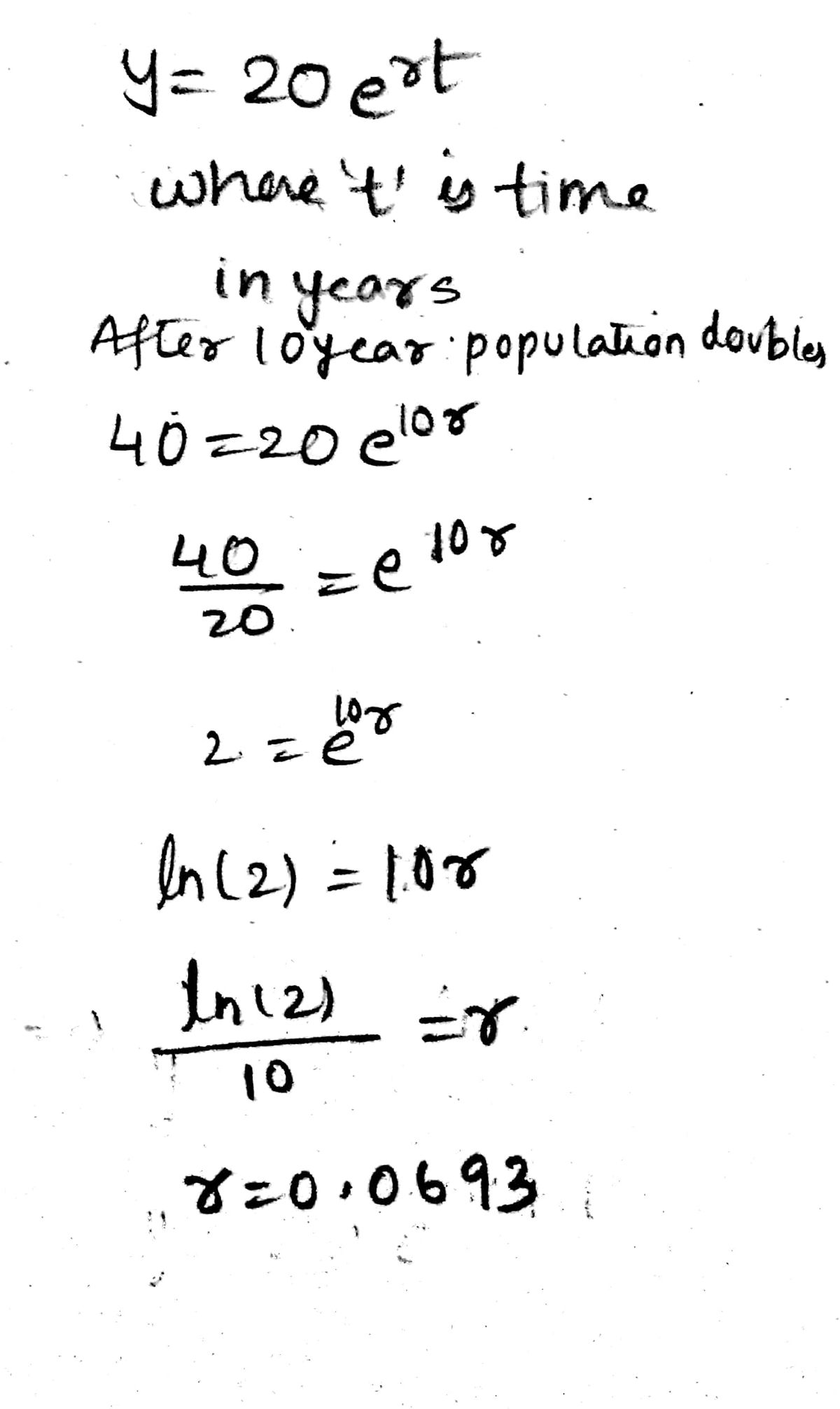**Population Growth Problem** A population that initially has 20 birds approximately doubles every 10 years. Which graph represents this population growth? **Graph Analysis:** 1. **Graph (1):** - **X-axis:** Number of Years (0 to 40) - **Y-axis:** Number of Birds (0 to 80) - **Shape:** Exponential curve starting at 20 birds and rising steeply, indicating exponential growth which matches the population doubling over time. 2. **Graph (2):** - **X-axis:** Number of Years (0 to 20) - **Y-axis:** Number of Birds (0 to 20) - **Shape:** Downward curve indicating a decrease in population, which does not match the given condition of the population doubling. 3. **Graph (3):** - **X-axis:** Number of Years (0 to 40) - **Y-axis:** Number of Birds (0 to 80) - **Shape:** Exponential curve similar to graph (1) but with a steeper increase, showing a fast-growing population. This is also consistent with the doubling nature specified. 4. **Graph (4):** - **X-axis:** Number of Years (0 to 40) - **Y-axis:** Number of Birds (0 to 80) - **Shape:** Linear line starting from 20 up to 80, suggesting a consistent rate of growth rather than exponential doubling. **Conclusion:** The graph that best represents the population growth where the number of birds doubles every 10 years is most likely graph (1) or graph (3), which show exponential growth patterns.
**Population Growth Problem** A population that initially has 20 birds approximately doubles every 10 years. Which graph represents this population growth? **Graph Analysis:** 1. **Graph (1):** - **X-axis:** Number of Years (0 to 40) - **Y-axis:** Number of Birds (0 to 80) - **Shape:** Exponential curve starting at 20 birds and rising steeply, indicating exponential growth which matches the population doubling over time. 2. **Graph (2):** - **X-axis:** Number of Years (0 to 20) - **Y-axis:** Number of Birds (0 to 20) - **Shape:** Downward curve indicating a decrease in population, which does not match the given condition of the population doubling. 3. **Graph (3):** - **X-axis:** Number of Years (0 to 40) - **Y-axis:** Number of Birds (0 to 80) - **Shape:** Exponential curve similar to graph (1) but with a steeper increase, showing a fast-growing population. This is also consistent with the doubling nature specified. 4. **Graph (4):** - **X-axis:** Number of Years (0 to 40) - **Y-axis:** Number of Birds (0 to 80) - **Shape:** Linear line starting from 20 up to 80, suggesting a consistent rate of growth rather than exponential doubling. **Conclusion:** The graph that best represents the population growth where the number of birds doubles every 10 years is most likely graph (1) or graph (3), which show exponential growth patterns.
Algebra and Trigonometry (6th Edition)
6th Edition
ISBN:9780134463216
Author:Robert F. Blitzer
Publisher:Robert F. Blitzer
ChapterP: Prerequisites: Fundamental Concepts Of Algebra
Section: Chapter Questions
Problem 1MCCP: In Exercises 1-25, simplify the given expression or perform the indicated operation (and simplify,...
Related questions
Question

Transcribed Image Text:**Population Growth Problem**
A population that initially has 20 birds approximately doubles every 10 years. Which graph represents this population growth?
**Graph Analysis:**
1. **Graph (1):**
- **X-axis:** Number of Years (0 to 40)
- **Y-axis:** Number of Birds (0 to 80)
- **Shape:** Exponential curve starting at 20 birds and rising steeply, indicating exponential growth which matches the population doubling over time.
2. **Graph (2):**
- **X-axis:** Number of Years (0 to 20)
- **Y-axis:** Number of Birds (0 to 20)
- **Shape:** Downward curve indicating a decrease in population, which does not match the given condition of the population doubling.
3. **Graph (3):**
- **X-axis:** Number of Years (0 to 40)
- **Y-axis:** Number of Birds (0 to 80)
- **Shape:** Exponential curve similar to graph (1) but with a steeper increase, showing a fast-growing population. This is also consistent with the doubling nature specified.
4. **Graph (4):**
- **X-axis:** Number of Years (0 to 40)
- **Y-axis:** Number of Birds (0 to 80)
- **Shape:** Linear line starting from 20 up to 80, suggesting a consistent rate of growth rather than exponential doubling.
**Conclusion:** The graph that best represents the population growth where the number of birds doubles every 10 years is most likely graph (1) or graph (3), which show exponential growth patterns.
Expert Solution
Step 1

Step by step
Solved in 2 steps with 2 images

Recommended textbooks for you

Algebra and Trigonometry (6th Edition)
Algebra
ISBN:
9780134463216
Author:
Robert F. Blitzer
Publisher:
PEARSON

Contemporary Abstract Algebra
Algebra
ISBN:
9781305657960
Author:
Joseph Gallian
Publisher:
Cengage Learning

Linear Algebra: A Modern Introduction
Algebra
ISBN:
9781285463247
Author:
David Poole
Publisher:
Cengage Learning

Algebra and Trigonometry (6th Edition)
Algebra
ISBN:
9780134463216
Author:
Robert F. Blitzer
Publisher:
PEARSON

Contemporary Abstract Algebra
Algebra
ISBN:
9781305657960
Author:
Joseph Gallian
Publisher:
Cengage Learning

Linear Algebra: A Modern Introduction
Algebra
ISBN:
9781285463247
Author:
David Poole
Publisher:
Cengage Learning

Algebra And Trigonometry (11th Edition)
Algebra
ISBN:
9780135163078
Author:
Michael Sullivan
Publisher:
PEARSON

Introduction to Linear Algebra, Fifth Edition
Algebra
ISBN:
9780980232776
Author:
Gilbert Strang
Publisher:
Wellesley-Cambridge Press

College Algebra (Collegiate Math)
Algebra
ISBN:
9780077836344
Author:
Julie Miller, Donna Gerken
Publisher:
McGraw-Hill Education